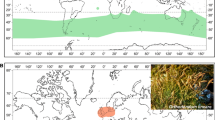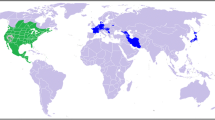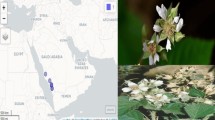Abstract
Growing global evidence demonstrates that not only the invasion of alien species has imposed serious threats to native biodiversity, but it also threatens health and economics. The raccoon (Procyon lotor), medium-sized mammal, native to North America, as a result of escapes or deliberate introductions in the mid-twentieth century, is now distributed across much of mainland Europe and the Caucasus and known as an alien invasive species. The raccoon was observed and reported for the first time in 1991 in the Caspian Hyrcanian mixed forests ecoregion in Iran, near the border of Azerbaijan. Although it has been almost three decades since the first report in the northwest of the country, there are not many official reports nor scientific research on its dispersal and adaptive behaviour. In this study, we provide new evidence on the current distribution range and predict the potential distribution range and thus invasion risk of the raccoon under climate change in Iran. We trained an ensemble of species distribution models trained in native and European invaded range and transferred it over space and time to Iran in 6 future climate scenarios. We also calculated the potential dispersal range of the raccoon per year and explored potential invasion corridors. Our results show that the raccoon inclined to expand in the forests and rangelands near the Caspian Sea and toward west Iran. Our work provides evidence to conservationists and decision-makers to further focus on the areas where the species will most likely expand, under the future scenarios of the climate change in 2050.




Similar content being viewed by others
References
Aliev FF, Sanderson GC (1966) Distribution and status of the raccoon in the Soviet Union. J Wildl Manage 30(3):497–502
Animal Rights Watch (2015) Trading the raccoon in petshops and sidewalks in Iran. <http://arw.ir/?p=62614>. Accessed 30 June 2019
Araújo MB, New M (2007) Ensemble forecasting of species distributions. Trends Ecol Evol 22:42–47
Armstrong JS, Collopy F (1992) Error measures for generalizing about forecasting methods: empirical comparisons. Int J Forecast 8:69–80
Bartoszewicz M, Okarma H, Zalewski A, Szczesna J (2008) Ecology of the raccoon (Procyon lotor) from western Poland. Ann Zool Fennici 45:291–298
Beltrán-Beck B, García FJ, Gortázar C (2012) Raccoons in Europe: disease hazards due to the establishment of an invasive species. Eur J Wildl Res 58:5–15
Biedrzycka A, Zalewski A, Bartoszewicz M, Okarma H, Jędrzejewska E (2014) The genetic structure of raccoon introduced in Central Europe reflects multiple invasion pathways. Biol Invasions 16:1611–1625
Bivand R, Lewin-Koh N (2013) maptools: Tools for reading and handling spatial objects. R package version 0.8, 23, Chicago
Blackburn GA, Steele CM (1999) Towards the remote sensing of matorral vegetation physiology: relationships between spectral reflectance, pigment, and biophysical characteristics of semiarid bushland canopies. Remote Sens Environ 70:278–292
Breiman L (2001) Random forests. Mach Learn 45:5–32
Canova L, Rossi S (2009) First records of the northern raccoon Procyon lotor in Italy. Hystrix It J Mamm 19(2). https://doi.org/10.4404/HYSTRIX-19.2-4428
Catford JA, Daehler CC, Murphy HT, Sheppard AW, Hardesty BD, Westcott DA, Rejmánek M, Bellingham PJ, Pergl J, Horvitz CC, Hulme PE (2012) The intermediate disturbance hypothesis and plant invasions: implications for species richness and management. Perspect Plant Ecol Evol Syst 14:231–241
DAISIE (2008) European invasive alien species gateway. http://www.europealiens.org/. Accessed 29 June 2019
Dornelas M, Gotelli NJ, McGill B, Shimadzu H, Moyes F, Sievers C, Magurran AE (2014) Assemblage time series reveal biodiversity change but not systematic loss. Science 344(6181):296–299
Drake JM, Randin C, Guisan A (2006) Modelling ecological niches with support vector machines. J Appl Ecol 43:424–432
Duscher T, Zeveloff SI, Michler FU, Nopp-Mayr U (2018) Environmental drivers of raccoon (Procyon lotor L.) occurrences in Austria–established versus newly invaded regions. Arch Biol Sci 70:41–53
Elith J, Anderson PR, Dudík M et al (2006) Novel methods improve prediction of species’ distributions from occurrence data. Ecography 29:129–151
Farashi A, Naderi M (2017) Predicting invasion risk of raccoon Procyon lotor in Iran using environmental niche models. Landsc Ecol Eng 13:229–236
Farashi A, Kaboli M, Karami M (2013) Predicting range expansion of invasive raccoons in northern Iran using ENFA model at two different scales. Ecol Inform 15:96–102
Fielding AH, Bell JF (1997) A review of methods for the assessment of prediction errors in conservation presence/absence models. Environ Conserv 24:38–49
Fischer ML, Hochkirch A, Heddergott M, Schulze C, Anheyer-Behmenburg HE, Lang J, Michler FU, Hohmann U, Ansorge H, Hoffmann L, Klein R, Frantz AC (2015) Historical invasion records can be misleading: genetic evidence for multiple introductions of invasive raccoons (Procyon lotor) in Germany. PLoS One 10(5):e0125441
Frantz AC, Cyriacks P, Schley L (2005) Spatial behaviour of a female raccoon (Procyon lotor) at the edge of the species’ European distribution range. Eur J Wildl Res 51:126–130
Friedman JH (2001) Greedy function approximation: a gradient boosting machine. Ann Stat 29:1189–1232
GBIF.org (15 August 2020a) GBIF Occurrence Download https://doi.org/10.15468/dl.j7jhry
GBIF.org (15 August 2020b) GBIF Occurrence Download https://doi.org/10.15468/dl.9ezd5f
Groom MJ, Meffe GK, Carroll CR, Andelman SJ (2006) Principles of conservation biology (No. Sirsi) i9780878935185). Sinauer Associates, Sunderland
Hair JF Jr, Anderson RE, Tatham RL, Black WC (1995) Multivariate data analysis, 3rd eds. Macmillan, New York
Hasties TJ, Tibshirani RJ (1990) Generalized additive models. Taylor & Francis, London
Hellmann JJ, Byers JE, Bierwagen BG, Dukes JS (2008) Five potential consequences of climate change for invasive species. Conserv Biol 22:534–543
Hijmans RJ, Cameron SE, Parra JL, Jones PG, Jarvis A (2005) Very high resolution interpolated climate surfaces for global land areas. Int J Climatol: A J Roy Meteorol Soc 25:1965–1978
Hijmans RJ, Phillips S, Leathwick J, Elith J (2013) dismo: Species distribution modeling. R package version 0.8-17. R Foundation for Statistical Computing, Vienna
Hijmans RJ, Etten JV, Cheng J, Mattiuzzi M, Sumner M, Greenberg JA et al (2015) Package ‘raster’. https://cran.r-project.org/web/packages/raster/raster.pdf. Accessed 1 June 2019
Hosmer DW, Lemeshow S (2000) Applied logistic regression, 2nd edn. John Wiley & Sons, New York
Ikeda T, Asano M, Matoba Y, Abe G (2004) Present status of invasive alien raccoon and its impact in Japan. Glob Environ Res 8:125–131
Karami M, Ghadirian T, Faizolahi K (2016) The atlas of the mammals of Iran. Iran Department of the Environment, Tehran
Kaufmann JH (1982) Raccoons and allies. In: Feldhamer GA, Thompson BC, Chapman JA (eds) Wild mammals of North America: biology, management, and conservation. Johns Hopkins, Baltimore, pp 567–585
Kauhala K (1996) Introduced carnivores in Europe with special reference to central and northern Europe. Wildlife Biol 2:197–204
Khosravifard S (2007) Archiving the raccoon’s dossier. Hamshahri website. <http://images.hamshahrionline.ir/hamnews/1384/840214/irshahr/zest.htm>. Accessed 20 April 2019
Liu C, White M, Newell G (2013) Selecting thresholds for the prediction of species occurrence with presence-only data. J Biogeogr 40:778–789
McCullagh P, Nelder JA (1989) Generalized linear models. Chapman & Hall, Boca Raton
Menard S (2002) Applied logistic regression analysis. Vol. 106. Sage, London
Merow C, Smith MJ, Edwards TC Jr, Guisan A, McMahon SM, Normand S, Thuiller W, Wüest RO, Zimmermann NE, Elith J (2014) What do we gain from simplicity versus complexity in species distribution models? Ecography 37:1267–1281
Michler FU, Hohmann U (2005) Investigations on the ethological adaptations of the raccoon (Procyon lotor L., 1758) in the urban habitat using the example of the city of Kassel, North Hessen (Germany), and the resulting conclusions for conflict management. In: XXVII IUGB-CONGRESS, Hannover, p 417
Miller ME, Hui SL, Tierney WM (1991) Validation techniques for logistic regression models. Stat Med 10:1213–1226
Mori E, Mazza G, Menchetti M, Panzeri M, Gager Y, Bertolino S, Di Febbraro M (2015) The masked invader strikes again: the conquest of Italy by the Northern raccoon. Hystrix It J Mamm 26(1):47–51
Naimi B (2015) Usdm: uncertainty analysis for species distribution models. R package version 1.1-15. R Doc. http://www.rdocu-mentation.org/packages/usdm. Accessed 1 June 2019
Naimi B, Araújo MB (2016) sdm: a reproducible and extensible R platform for species distribution modelling. Ecography 39:368–375
Pearce J, Ferrier S (2000) An evaluation of alternative algorithms for fitting species distribution models using logistic regression. Ecol Model 128:127–147
Pebesma E, Bivand RS (2005) Classes and methods for spatial data in R. R news 5:9–13
Phillips SJ, Anderson RP, Schapire RE (2006) Maximum entropy modeling of species geographic distributions. Ecol Model 190:231–259
Pyšek P, Richardson DM (2010) Invasive species, environmental change and management, and health. Annu Rev Environ Resour 35:25–55
Qian H, Ricklefs RE (2006) The role of exotic species in homogenizing the North American flora. Ecol Lett 9:1293–1298
R Core Team (2018) R: A language and environment for statistical computing. R Foundation for Statistical Computing, Vienna. https://www.R-project.org/
Salgado I (2018) Is the raccoon (Procyon lotor) out of control in Europe? Biodivers Conserv 27:2243–2256
Sanderson GC (1987) Raccoon. In: Novak M, Baker JA, Obbard ME, Malloch B (eds) Wild furbearer management and conservation in North America. Ontario Ministry of Natural Resources, Toronto, pp 487–499
Santini L, Di Marco M, Visconti P et al (2013) Ecological correlates of dispersal distance in terrestrial mammals. Hystrix. 24(2):181–186
Scalera R, Genovesi P, Essl F, Rabitsch W (2012) The impacts of invasive alien species in Europe. Eur Environ Agency Tech Rep 16:114
Seebens H, Gastner MT, Blasius B, Courchamp F (2013) The risk of marine bioinvasion caused by global shipping. Ecol Lett 16:782–790
Seoane J, Bustamante J, Díaz-Delgado R (2005) Effect of expert opinion on the predictive ability of environmental models of bird distribution. Conserv Biol 19:512–522
Sherman HB (1954) Raccoons of the Bahama-islands. J Mammal 35:126
Sinkins PA, Otfinowski R (2012) Invasion or retreat? The fate of exotic invaders on the northern prairies, 40 years after cattle grazing. Plant Ecol 213:1251–1262
Timm R, Cuarón AD, Reid F, Helgen K, González-Maya JF (2016) Procyon lotor. The IUCN Red List of Threatened Species 2016: e.T41686A45216638. https://doi.org/10.2305/IUCN.UK.2016-1.RLTS.T41686A45216638.en
Tollington S, Turbé A, Rabitsch W, Groombridge JJ, Scalera R, Essl F, Shwartz A (2017) Making the EU legislation on invasive species a conservation success. Conserv Lett 10:112–120
Usher MB (1988) Biological invasions of nature reserves: a search for generalisations. Biol Conserv 44:119–135
Vandekerkhove J, Cardoso AC, Boon PJ (2013) Is there a need for a more explicit accounting of invasive alien species under the Water Framework Directive. Manag Biol Invasions 4:25–36
Westman WE (1990) Park management of exotic plant species: problems and issues. Conserv Biol 4:251–260
Zeveloff SI, Dewitte E (2002) Raccoons: a natural history. UBC Press, Toronto
Author information
Authors and Affiliations
Corresponding author
Additional information
Publisher’s note
Springer Nature remains neutral with regard to jurisdictional claims in published maps and institutional affiliations.
Rights and permissions
About this article
Cite this article
Khosravifard, S., Skidmore, A.K., Toxopeus, A.G. et al. Potential invasion range of raccoon in Iran under climate change. Eur J Wildl Res 66, 100 (2020). https://doi.org/10.1007/s10344-020-01438-2
Received:
Revised:
Accepted:
Published:
DOI: https://doi.org/10.1007/s10344-020-01438-2




